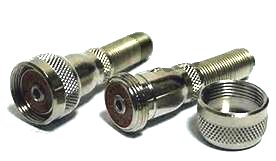Switchcraft 2501F
Switchcraft 2501F Vintage Microphone Connector. 2501F is the part number for a Swichcraft connector used with high impedance microphones up through about 1980. It was intended for coax style cable up to 0.281 inches (7.1 mm) outside diameter.
- Switchcraft 2501F
- Amphenol 2501-F (Model # 80-75-MC1F) / Amphenol 75-MC1F
Often it is referred to as simply "Microphone Connector," "WPI connector," "Heathkit Mic Connector," and "Amphenol Mini." Although incorrect, other terms help to identify the connector. Search for 2501F, vintage mic connector, Heathkit mic, B&K signal generator cable connector, Amphenol 75 MC1 connector, as a few examples relative to equipment having this type of connector. In ham radio these connectors are typical of older rigs made before PTT (push to talk) was common. It is a very common 80 series microphone connector found not only in radios, but public address (PA) and audio systems of that era. HeathKit is commonly known to used this connector.
Attachment is made with a 5/8-27 threaded ring that can be unthreaded over the body of the connector body allowing the female connector to become a male connector.
Wire connection was via solder. The center conductor is soldered to a hole resulting in a flat center contact. The cable shield is soldered to the strain-relief spring which is held in the body of the connector with a set screw.
With no provision for spring loading of the connection ring, vibration tends to loosen the threaded ring an create intermittent contact.
Soldering
Physically soldering these connectors is easy. Strip your cable, solder the shield to the spring, insert the cable and spring into the connector and solder the center conductor to the center of the connector. If you look at the entire assembly you can see that the strain relief spring does nothing to prevent the cable from spinning inside the sprint. If the cable spins inside the spring, but the center conductor is soldered to the center of the connector, sooner or later it will break loose. You want to try to take steps to guard against that.
